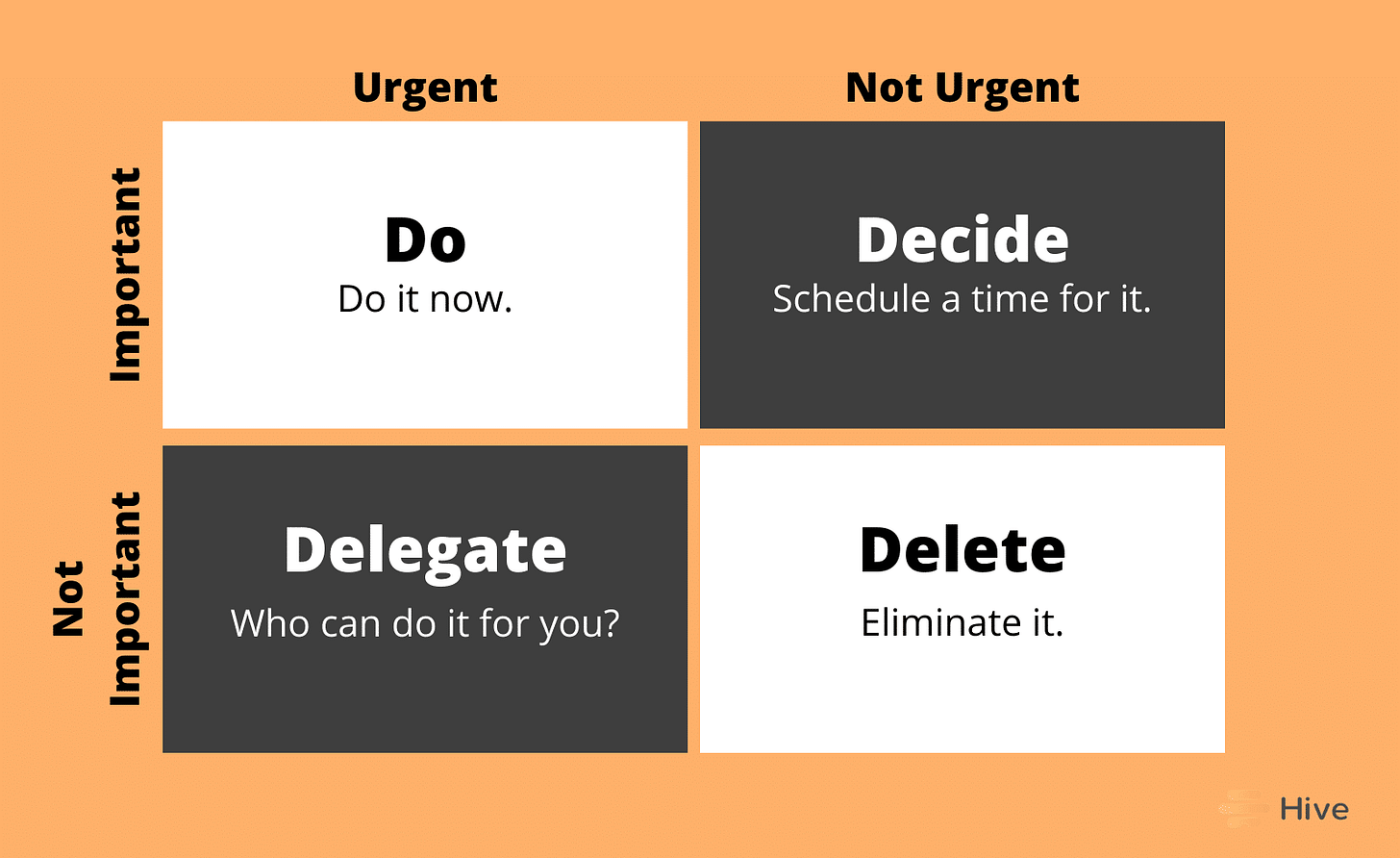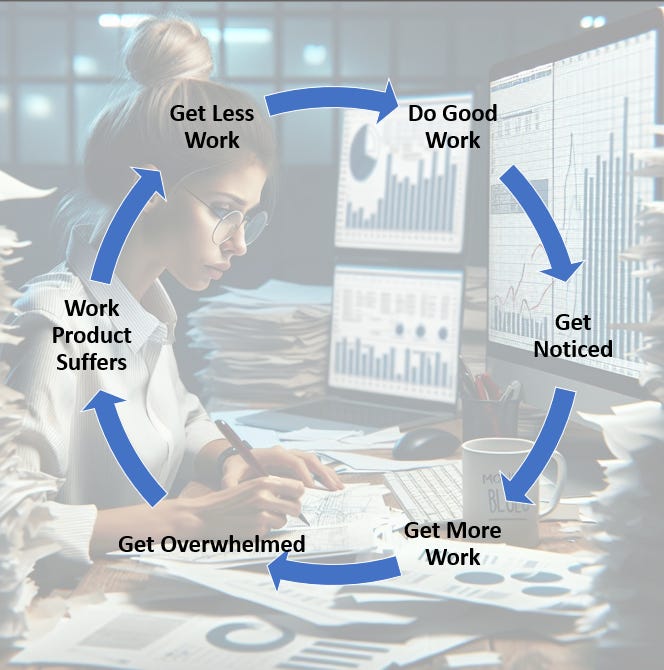We all know that the reward for good work is more work. Recently a friend put this a lot more eloquently: The price of success is expectation. Any way you put it, if you’re good at your job you can expect quick accession to the corner office a lot more work.
This is a good thing - it means you’re trusted to get the job done and put out quality work product. You’re spreading the old Funke name around the water cooler and it’s starting to stick, but it’s also bringing more “Got a sec?” messages that just add more to your plate. You need to recognize when too much is too much and find a way to turn down burnout-driving requests.

How Much is Too Much?
If you feel like you’re getting pulled in too many different directions, there’s likely one of two reasons: you are managing your time very poorly or you actually have too much work. The first thing to do is to sit down and look at all of your projects and initiatives and prioritize them to see if it’s the first one.
There’s a couple of ways to do this, as work has become so chaotic and complex that the trusty old to-do list is out of date. You have to do more than simple time management - you actually have to become your own project manager (and your team’s, depending on how many direct reports you have.)
A digital cottage industry has popped up around project management. There’s enough space (read: VC money) for companies like Monday, Asana, Todoist, TickTick, and Trello (just to name a few) to share the space of project management for the non-project manager. This doesn’t include the built-in tools like Microsoft’s To Do/Planner or Slack’s Canvases. There’s no shortage of ways to see how overwhelming your workload is, right at your fingtertips.
But these are just the platforms on which you’ll be putting your to-do list. The actual way you approach your to-do list is important in and of itself, and there are plenty of ways to do that.
I began with the simple list but it quickly became obsolete and as soon as I began managing a team I moved over to the Eisenhower matrix. Developed by our beloved 34th president, the Eisenhower matrix’s goal is to avoid the “everything is urgent” fallacy of work and to truly have the doer focus on what is both important and urgent.
It has served me well, but I do find myself getting pulled in too many different directions that a single matrix won’t do. I also believe multiple matrices (either by client or by region - or by client and region) would get too unwieldy. I’m still working through how to manage this, as it’s uncharted territory.
Is This What Too Much Work Looks Like?
If a relatively advanced to-do list system isn’t working out for you, it could very well be that you have too much on your plate.
That good work that got you more work? That was likely made possible by a manageable workload, which makes this counterintuitive process all the more unwieldy. If your workload gets too much, you will be too stretched and your work product will suffer, which will lead to decreased expectations and workload, thus starting the whole process again. It’s a predictably unpredictable cycle and one that will lead to mediocrity, or worse (burnout.)
This is a cycle that it’s important to look out for - both in yourself and your team. If you’re consistently going to the same person on your team because they’re dependable, get the job done right, and require little oversight that’s great. But if you’re setting them up for this cycle, you’ll lose a quality team member quickly.
If you see yourself on the other end of that, you need to take immediate steps to slow its progress so you can maintain the high level of work product and output that got you here, but also avoid burning out and/or watering down your product to meet all of your newfound obligations. It’s a tricky balance.
You’ll Be Saying No No No No No
When the requests come pouring in, some of them are going to have to abide by Destiny’s Child’s debut single and simply be told no.
It’s not easy to say no at work - and what makes it harder is that if the reason you’re overwhelmed is that your work is getting recognized around the office, you’ll probably have senior leaders and their teams asking you for your assistance. This makes it infinitely harder to say no.
But saying no doesn’t start and end with telling your boss to pound sand. There are ways to approach the conversation, and providing context around why you’re saying no is crucial. There’s no way to make the requestor happy to be told they can’t get something, but you need to ensure you let them down easy.
Learning to do this won’t only help to keep you sane and productive, but will lead to more success in the long run. It’s not easy, but if you are finding it especially difficult even as you recognize the symptoms of overwork, you may want to look into people pleasing and whether or not you fit that bill. Because if you are a classic people pleaser, there are significant effects outside of your professional life and rooting out those causes will help you both at work and at home.
Use This Sparingly
We’ve talked about how when work gets insane, there’s actually opportunities afoot. Before you say no, you need to ensure that you’re not letting a good opportunity go by and merely doing it to stay within your comfort zone. That’s not what the magic word of “no” is for - view it more as a survival tactic than a reliable tool in your professional toolbelt.
And herein lies the problem of saying no at work - this is entirely subjective. Don’t do it to avoid pain (one of the four ego needs), but do it to avoid burnout. This line won’t always be easy to spot, so consistently checking in on yourself is crucial so you know when to say no and can be confident that it’s the right - albeit difficult - move.
Grab Bag Sections
WTF Shorts in the Office: The temperature grazed 80F yesterday in New York and I was subject to multiple male legs in the office. It’s going to be a long summer if this is how people are acting on the first decent day of the year. It’s not even May!
Shorts are not office workwear. Full stop. There are plenty of full-length alternatives that are appropriate for summer (capris are a European problem and I will let Brussels deal with it on their own.) Wear some light khakis, wear some linen, but whatever you do leave your shorts at home and save them for the weekend.
And do not get me started on open toed footwear for men. Last year I almost went to HR when I saw someone with a 6” inseam short also wear flip flops TO THE OFFICE. Keep those gremlins packed away in shoes where they are supposed to be, especially in a major metro like NY (you’re riding the subway with those things less than an inch from the subway floor?!?)
This is the energy I’d like to bring to the WTF section every week, but I reserve this kind of ire for few items on this great planet we all share together. Shorts in the office and men’s toes in a business setting fit that bill and make me apoplectic. Ban shorts in the office. Now.
Album of the Week: I don’t go to a lot of concerts, and even before kids I wasn’t a huge live music fan. One concert I was able to get to before riding off into the sunset of suburban fatherhood was Allen Stone, and it was glorious.
I first discovered Stone from the chorus on Macklemore’s “Neon Cathedral” from The Heist. Digging into Stone’s discography was easy: at the time he really only had a self-titled album and that is the one that has stuck with me since.
The album starts of with a lot of energy and moves into the kind of soul that would influence Stone after he left the church he was raised in. “Satisfaction” is a keeper, with its deep bassline and Stone’s anger dominating. The falsetto and horns in “Contact High” are not to be missed. And, of course, the crown jewel of the album is the outro (love when that happens) - “Unaware.” Pick up some of Stone’s blue-eyed soul with a Spokane twist.
Quote of the Week: “That’s weird. There weren’t any cars in Frozen…” - My 5-year old daughter, almost realizing that the Elsa cosplayer getting into her car after appearing at her friend’s birthday party was not, in fact, the real Elsa. Almost.
See you next week!








